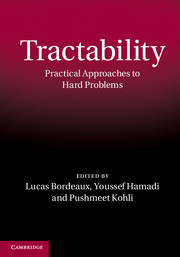Book contents
- Frontmatter
- Contents
- Contributors
- Introduction
- Part 1 Graphical Structure
- Part 2 Language Restrictions
- Part 3 Algorithms and their Analysis
- Part 4 Tractability in Some Specific Areas
- 10 Efficient Submodular Function Minimization for Computer Vision
- 11 Towards Practical Graph-Based, Iteratively Decoded Channel Codes: Insights through Absorbing Sets
- Part 5 Heuristics
11 - Towards Practical Graph-Based, Iteratively Decoded Channel Codes: Insights through Absorbing Sets
from Part 4 - Tractability in Some Specific Areas
Published online by Cambridge University Press: 05 February 2014
- Frontmatter
- Contents
- Contributors
- Introduction
- Part 1 Graphical Structure
- Part 2 Language Restrictions
- Part 3 Algorithms and their Analysis
- Part 4 Tractability in Some Specific Areas
- 10 Efficient Submodular Function Minimization for Computer Vision
- 11 Towards Practical Graph-Based, Iteratively Decoded Channel Codes: Insights through Absorbing Sets
- Part 5 Heuristics
Summary
This chapter discusses recent advances in modern coding theory, in particular the use of popular graph-based codes and their low complexity decoding algorithms. We describe absorbing sets as the key object for characterizing the performance of iteratively-decoded graph-based codes and we propose several directions for future investigation in this thriving discipline.
Chapter Overview
Every engineered communication system, ranging from satellite communications to hard disk drives to Ethernet must operate under noisy conditions. The key to reliable communication and storage is to add an appropriate amount of redundancy to make the system reliable. The field of channel coding is concerned with constructing channel codes and their decoding algorithms: controlled redundancy is introduced into a message prior to its transmission over a noisy channel (the encoding step), and this redundancy is removed from the received noisy string to unveil the intended message (the decoding step). The encoded message is referred to as the codeword. The collection of all codewords is a channel code. Assuming all the messages have the same length, and all the codewords have the same length, the ratio of message length to codeword length is the code rate. To make coding systems implementable in practice, channel codes must provide the best possible protection to noise while their decoding algorithms must be of acceptable complexity.
There is a clear tension with this dual goal: if a channel code protects a fairly long encoded message with relatively few but carefully derived redundancy bits (necessary for high performance), the optimal, maximum likelihood decoding algorithm has exponential complexity.
Information
- Type
- Chapter
- Information
- TractabilityPractical Approaches to Hard Problems, pp. 304 - 328Publisher: Cambridge University PressPrint publication year: 2014
